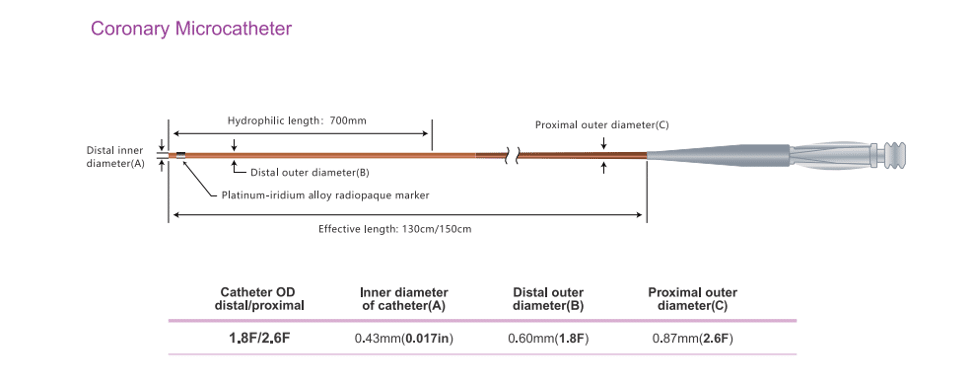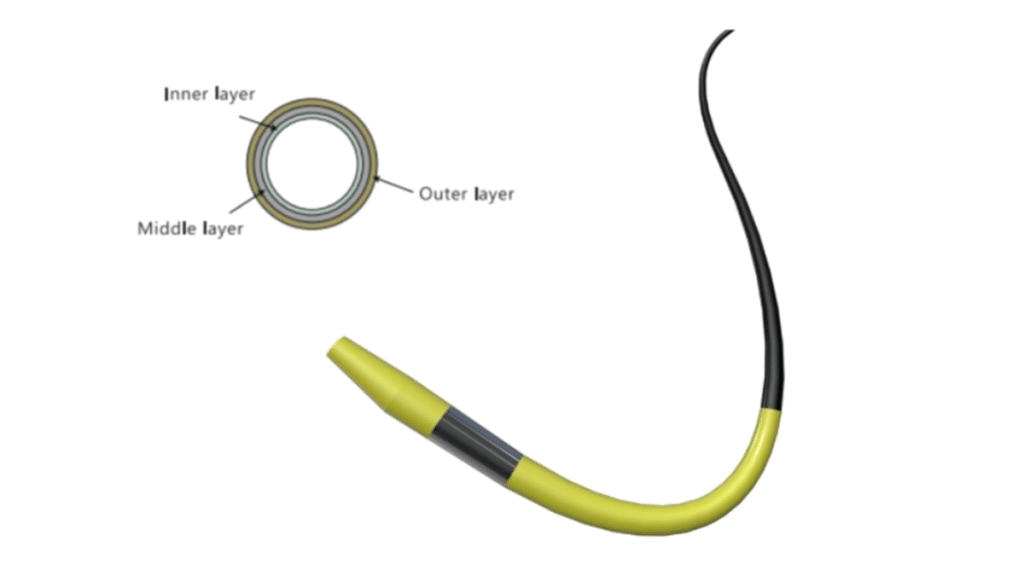What is a Microcatheter?
A microcatheter is a tool for vascular navigation, which has diameters of 0.70-1.30 mm with hydrophilic coatings that lower friction in tortuous anatomy. Its steerable or pre-shaped angled tip allows for maneuvering in calcified or angulated vessels in coronary or neurovascular interventions. In PCI, microcatheters support guidewires while stabilizing their path during lesion crossing or balloon delivery, making them crucial for treating left main stenosis or heavily calcified lesions.
Similarly, their lumen sizes (0.015-0.021 inches) are optimized for contrast injection in neuro interventions. They help to reduce the risk of embolism during clot crossing in acute ischemic stroke. The coil pitch within the catheter wall enhances flexibility and pushability, enabling access to distal lesions in challenging vasculature. Therefore, when used with coronary guidewires, microcatheters transform complex anatomy into accessible paths for device delivery and therapeutic success.
Common Uses of Microcatheter
Microcatheters are thin-walled, small-diameter, specialized catheters designed to navigate complex vasculature within the human body. Their flexibility and ultra-low profile allow for distant vascular access without tissue harm.
Microcatheters allow for less invasive neurovascular treatments and peripheral embolization while delivering embolic agents, stents, or therapeutic medicines. Their torque control and trackability improve operator accuracy in difficult interventional procedures, such as coronary and neurovascular interventions. The microcatheter’s function in safely crossing complicated pathways is key to procedure accomplishment and patient outcomes.
- Vascular embolization procedures
- Aneurysm treatment
- Stroke intervention
- Tumor embolization
- Diagnostic angiography
- Delivery of stents or coils
- Access to tortuous or small vessels
- Drug delivery
- Biopsy procedures
- Chronic total occlusion (CTO) crossing
- Peripheral vascular disease treatment
- Cardiac catheterization
- Neurovascular interventions
- Support during guidewire navigation
- Endovascular repair of arteriovenous malformations (AVMs)
- Treatment of gastrointestinal bleeding
- Interventional radiology
- Chemoembolization
- Management of traumatic vascular injuries
Benefits of Using Microcatheter
Precision
Microcatheters offer precision thanks to their fine diameters and flexible tips. It gives targeted navigation through tortuous vascular structures. For example, microcatheters can reach deep, small-caliber vessels with negligible vessel trauma in aneurysm coiling or arteriovenous malformation embolization. Their hydrophilic coatings reduce friction, enhancing maneuverability within complex vasculature.
Minimally Invasive
Microcatheters revolutionize minimally invasive interventions by eliminating the need for large-caliber access sheaths and reducing the risk of vascular injury. In transarterial chemoembolization for liver tumors, microcatheters can deliver chemotherapeutic agents to the tumor-feeding arteries, sparing healthy tissue. By accessing peripheral branches, they provide treatment efficacy with lower systemic exposure. Furthermore, their small gauge minimizes patient recovery time and reduces post-procedural complications, such as hematomas, ensuring procedural safety in patients with fragile or diseased vessels.
Versatility
The microcatheter’s design expedites resourcefulness across interventional radiology, cardiology, and neurovascular therapy. For instance, microcatheters in crossing CTOs during percutaneous coronary interventions show their flexibility. Moreover, microcatheters can accommodate various guidewires and withstand high-pressure equipment, ensuring compatibility with balloon angioplasty, embolization, and intra-arterial blood shunting procedures.
So, complex lesion management needs microcatheters. Even in difficult settings, their accuracy, least invasiveness, and adaptability help access, treat, and maintain fragile vascular systems.
Coronary Microcatheter by Shunmei Medical

Shunmei Medical is one of the leading catheter manufacturers and catheter suppliers.
Its Coronary Microcatheter features a stainless steel braiding construction, which provides kink resistance, support lumen integrity, and navigation through compact, tortuous coronary vessels. Its soft and tapered tip design enhances maneuverability and flexibility, facilitating safe passage through narrow septal branches and microchannels. The PTFE inner layer gives guidewire tracking and a smooth channel for guidewire exchanges or contrast medium infusion. Additionally, the flexible distal segment with a hydrophilic coating lets the microcatheter advance through distal tortuous vessels.
Shunmei Medical Co., Ltd. holds ISO 13485 certification and the CE mark, highlighting its strict adherence to international standards and relentless pursuit of quality.
This company provides a comprehensive suite of microcatheters, including the Coronary microcatheter, Peripheral microcatheter, and Neurovascular microcatheter.
Conclusion
Because of their accuracy and adaptation, microcatheters are essential for neurovascular, cardiovascular, and peripheral therapies. Microcatheters in chronic total occlusion operations allow guidewire exchange and regulated contrast agent distribution in complicated coronary anatomies. In peripheral interventions, they help bridge severely calcified or tortuous lesions for accurate drug administration in critical limb ischemia therapies or transarterial chemoembolization. Overall, the versatility and flexibility of microcatheters make them indispensable instruments in modern interventional treatments.
Reference:
[1] What is a microcatheter?
Available at: https://www.medicaltubingandextrusion.com/what-is-a-microcatheter/ (Accessed: 12 December 2024)
